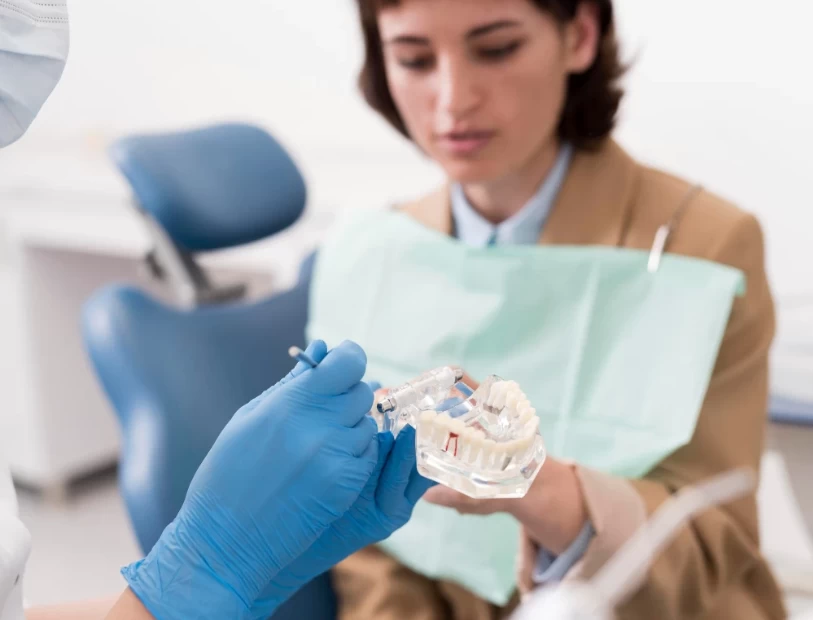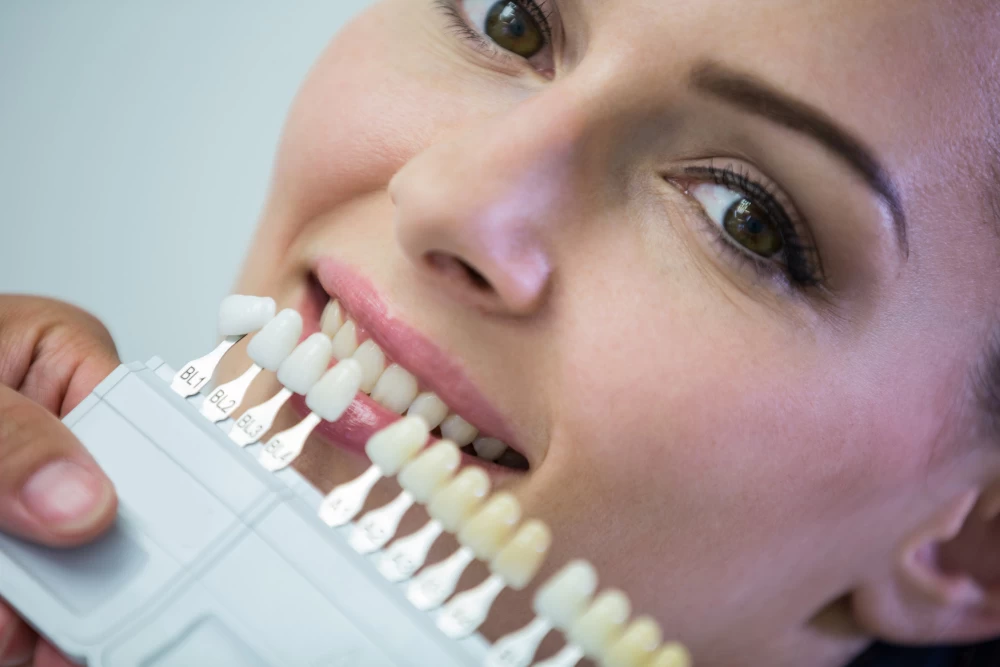
What is Porcelain Lamina?
- What is Porcelain Lamina?
- Is Dental Aesthetics Porcelain Lamina Healthy?
- How Many Types Of Porcelain Lamina Are There?
- Who is Applied to Porcelain Lamina?
- How is Dental Aesthetics Made from Porcelain Lamina?
Porcelain laminates, also known as dental aesthetic dental veneers or dental porcelain laminates, are thin ceramic material shells specially produced to fit the front surface of the teeth. It is designed to improve the appearance of teeth and improve dental aesthetics.
Porcelain laminates are commonly used in cosmetic dentistry to solve a number of dental issues such as:
- Discoloration: Teeth that are severely stained or discolored and do not respond well to teeth whitening procedures may benefit from porcelain laminates. Veneers can be color matched to achieve a natural and brighter smile.
- Chipped or cracked teeth: Teeth that are chipped, cracked or with small fractures can be covered with porcelain laminates to restore their appearance and provide strength.
- Gaps between teeth: Veneers can be used to close small gaps between teeth without the need for orthodontic treatment.
- Misaligned or uneven teeth: Porcelain laminates can mask the appearance of misalignment or irregularity, creating the illusion of straighter teeth.
The process of getting dental porcelain laminates typically involves several steps. First, the dentist will do a thorough examination and take impressions of your teeth. Veneers are then custom made in a dental laboratory to ensure a precise fit. At the next appointment, a small amount of enamel can be removed from the front surface of the teeth to create space for veneers. The laminates are then adhered to the teeth using a dental adhesive and cured with a special light.
Porcelain laminates are known for their natural appearance and durability. They are stain resistant and can last for many years with proper care, including regular brushing, flossing and dental checkups.
It is important to note that the information provided here is based on general knowledge and practice up to September 2021. It is always best to consult a qualified dentist for the most accurate and up-to-date information regarding dental procedures.
Is Dental Aesthetics Porcelain Lamina Healthy?
Porcelain veneers, also known as porcelain veneers or dental laminates, are thin porcelain shells that are specially produced and adhered to the front surface of the teeth. They are often used to improve the appearance of teeth by changing their color, shape, size or length. Porcelain veneers can be an effective solution for a variety of cosmetic dental issues such as discoloration, chipped or worn teeth, gaps between teeth, and irregular or misaligned teeth.
In terms of dental aesthetics, porcelain veneers can provide a natural and attractive result. They are highly customizable allowing the dentist to match the color, shape and size of veneers to the surrounding natural teeth. Porcelain is very similar to the appearance of natural tooth enamel and has a smooth, stain-resistant surface that can contribute to a brighter smile.
However, it is important to note that placing porcelain lamina veneers requires some preparation of natural teeth. This typically involves removing a thin layer of enamel from the front surface of the teeth to create space for the veneers. While this process is generally safe and minimally invasive, it is irreversible, meaning that teeth will always need some form of restoration after veneers have been placed.
In addition, the long-term health of porcelain coated teeth depends on proper oral hygiene and regular dental care. It is very important to maintain good oral hygiene practices, including brushing twice a day, flossing daily, and visiting your dentist for regular checkups and cleanings. While porcelain veneers themselves are not susceptible to decay, the underlying natural teeth can still be at risk if not properly cared for.
In general, when placed by a skilled dentist and provided with good oral hygiene, porcelain veneers can be a healthy option for improving dental aesthetics. It is important to consult a qualified dentist who can assess your particular situation, discuss the potential benefits and risks, and help determine if porcelain veneers are the right choice for you.
How Many Types Of Porcelain Lamina Are There?
Porcelain veneers, also known as porcelain veneers or dental laminates, are thin porcelain shells attached to the front surface of teeth to improve their appearance.
There are generally two types of porcelain laminate based on the manufacturing process and the materials used:
- Feldspartik Porcelain Lamina: This type of lamina is made from layers of feldspar porcelain, a traditional dental ceramic. Feldspar porcelain is highly aesthetic and provides excellent translucency, allowing it to mimic the natural appearance of teeth. These laminates are usually produced by a dental technician in a dental laboratory.
- Lithium Disilicate (e.max) Porcelain Lamina: This type of lamina is made of lithium disilicate glass-ceramic material. It is known for its high strength and durability, making it suitable for both anterior (front) and posterior (back) teeth. E.max laminates are generally produced using computer aided design and computer aided manufacturing (CAD/CAM) technology and allow for precise customization.
Both types of porcelain laminates can be used to address a variety of cosmetic dental concerns such as discoloration, chipping, cavities and misalignment of teeth. The choice between the two types depends on factors such as the patient's specific needs, the desired esthetic result, and the dentist's recommendation. It is important to consult a qualified dentist or prosthodontist to determine the most appropriate type of porcelain lamina for individual cases.

Who is Applied to Porcelain Lamina?
Porcelain veneers are typically applied by dentists, especially cosmetic dentists or prosthodontists. These are specialists with additional training and expertise in aesthetic dentistry and dental prosthetics. They have the necessary knowledge and skills to assess the patient's dental condition, design and apply veneers to the teeth.
Before applying porcelain laminate veneers, a comprehensive assessment of the patient's dental health is made. This includes examining the teeth, gums, and overall oral health to ensure the patient is a suitable candidate for veneers. If the patient has problems such as tooth decay, gum disease or structural problems, these conditions are typically addressed before the veneer is applied.
When a patient is deemed suitable for veneers, the dentist will prepare the teeth by removing a thin layer of enamel from the anterior surface. This allows the veneers to adhere properly to the teeth and provides a natural-looking result. Impressions of the teeth are then taken to create custom-made veneers that fit the patient's unique dental anatomy.
The application process involves cleaning and abrading the teeth to create a suitable surface for bonding. A dental adhesive is applied to the veneers and carefully placed over the teeth. The dentist will ensure proper alignment, fit and color match before permanently bonding the veneers in place using a special curing light or dental cement.
In general, the application of porcelain lamina veneers requires the expertise of dentists with training and experience in cosmetic dentistry. It is important to consult a qualified dentist or prosthodontist to determine if veneers are the right option for your specific dental needs.
The dentist will examine your teeth, take impressions, and possibly perform x-rays or other diagnostic tests. Together you will plan the desired result and determine whether porcelain laminate veneers are suitable for you.
- Tooth Preparation: A small amount of enamel is usually removed from the front surface of the teeth to make room for the veneers. This is usually done under local anesthesia for your comfort. The amount of enamel removed is usually minimal, equivalent to the thickness of the coating to be placed.
- Impression: After the teeth are prepared, an impression or mold of your teeth is taken. This impression is sent to a dental laboratory, where porcelain laminate veneers will be custom-made to match the shape and color characteristics determined during the treatment planning stage.
- Temporary Veneers: While permanent veneers are produced in the dental laboratory, temporary veneers can be placed on your teeth to protect them and give you a better appearance.
- Bonding: Once permanent veneers are ready, your cosmetic dentist will check their fit and color. Veneers can be cut and adjusted as needed to achieve the desired result. The dentist then cleans and abrades the surface of your teeth, which aids in the bonding process. A dental adhesive is applied and veneers are carefully placed on your teeth. A special light is used to activate the adhesive and securely adhere the veneers to your teeth.
- Final Adjustments: After the veneers are bonded, your dentist will make all necessary final adjustments to ensure proper bite and alignment. They can also polish coatings for a smooth and natural looking finish.
Porcelain laminate veneers are known for their natural appearance, durability and durability. They are stain resistant and can provide long-term cosmetic improvements to your smile when properly cared for. It is important to maintain good oral hygiene practices and regular dental check-ups to ensure the longevity of your dental aesthetics.
How is Dental Aesthetics Made from Porcelain Lamina?
Dental aesthetics made of porcelain, especially porcelain laminate veneers, are widely used in cosmetic dentistry to improve the appearance of teeth. Porcelain lamina veneers are thin dental porcelain shells specially produced to fit the front surface of the teeth. It is designed to improve the color, shape, size and overall appearance of teeth.
The process of creating dental aesthetics with porcelain laminate veneers typically includes the following steps:
- Consultation and Treatment Planning: You will meet with a cosmetic dentist to discuss your goals and expectations. The dentist will examine your teeth, take impressions, and possibly perform x-rays or other diagnostic tests. Together you will plan the desired result and determine whether porcelain laminate veneers are suitable for you.
- Tooth Preparation: A small amount of enamel is usually removed from the front surface of the teeth to make room for the veneers. This is usually done under local anesthesia for your comfort. The amount of enamel removed is usually minimal, equivalent to the thickness of the coating to be placed.
- Impression: After the teeth are prepared, an impression or mold of your teeth is taken. This impression is sent to a dental laboratory, where porcelain laminate veneers will be custom-made to match the shape and color characteristics determined during the treatment planning stage.
- Temporary Veneers: While permanent veneers are produced in the dental laboratory, temporary veneers can be placed on your teeth to protect them and give you a better appearance.
- Bonding: Once permanent veneers are ready, your cosmetic dentist will check their fit and color. Veneers can be cut and adjusted as needed to achieve the desired result. The dentist then cleans and abrades the surface of your teeth, which aids in the bonding process. A dental adhesive is applied and veneers are carefully placed on your teeth. A special light is used to activate the adhesive and securely adhere the veneers to your teeth.
- Final Adjustments: After the veneers are bonded, your dentist will make all necessary final adjustments to ensure proper bite and alignment. They can also polish coatings for a smooth and natural looking finish.
Porcelain laminate veneers are known for their natural appearance, durability and durability. They are stain resistant and can provide long-term cosmetic improvements to your smile when properly cared for. It is important to maintain good oral hygiene practices and regular dental check-ups to ensure the longevity of your dental aesthetics.



